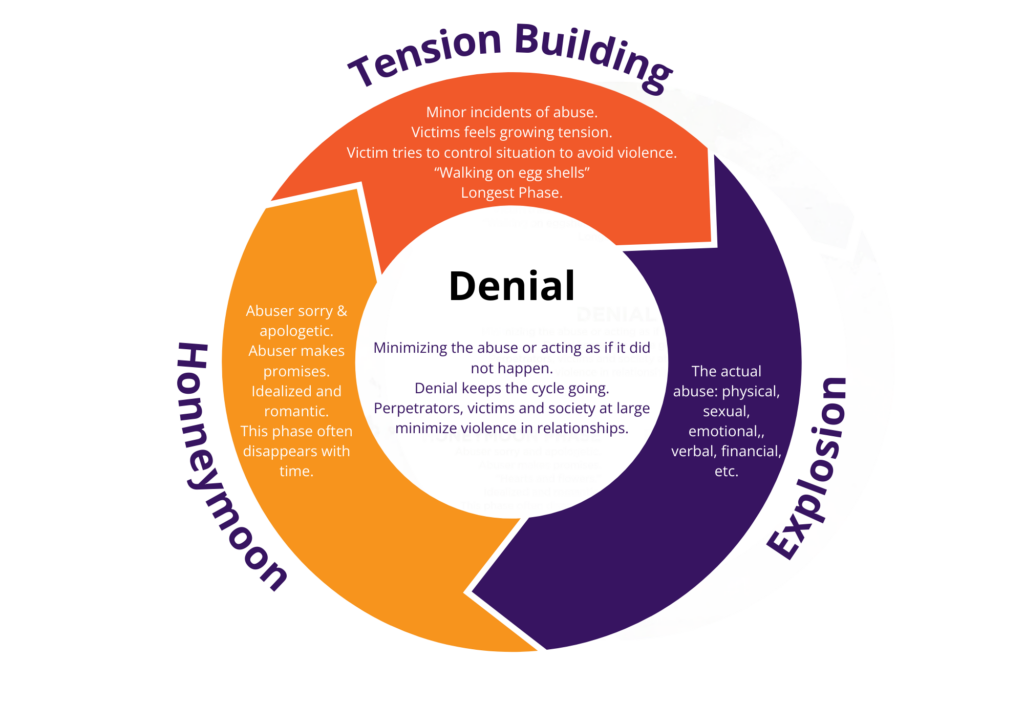What is Abuse?
Defining Family and Domestic Violence
Family and Domestic Violence is a pattern of behaviour in any type of relationship that is used to gain or maintain power and control and cause fear. The abuse may be physical, sexual, verbal, financial, emotional, technological or psychological. The type of abuse experienced may include one or more than one type of abuse and includes any behaviours that frighten, intimidate, terrorize, manipulate, hurt, humiliate, blame or injure someone.
Many people in the community, including survivors of domestic violence believe that unless physical or sexual violence has not occurred within an intimate partner relationship, they are not experiencing family and domestic violence.
Family and domestic violence can occur;
- within a family of parents and siblings
- in an intimate partner relationship (with or without children)
- with a former intimate partner
- within any type of gender binary or non-binary human relationship
- from a child toward a parent (Elder abuse)
- from a parent to a child (Child abuse)


Controlling Behaviours
Family and Domestic Violence often starts with someone using controlling behaviour in a subtle way and it is not recognized as an abuse of power. A survivor may feel that the perpetrator of violence is behaving this way because they care or are concerned about them, and this is commonly how the violence is justified by the perpetrator. The behaviour may be focused on contacting the survivor by phone constantly and insisting they spend more time together or unexpectedly turning up at events, activities or the survivor’s place of employment under the guise of concern or a gesture of romance.
Whilst it may not be obvious initially, over time the behaviour becomes more and more controlling with the intent of isolating the survivor and controlling all her movements, communication and decision making. The controlling behaviour used may include all or some of the types of abuse to maintain the power and control over the survivor.
The behaviours are not the result of mental illness, substance abuse, anger management or loss of control. They are carefully targeted at who/when/how and why the abuse occurs and often include threats to harm if others are informed about the abuse or the survivor gives an indication, they are attempting to leave the relationship.
Using these controlling behaviours is a choice and over time follows a pattern of violence called the Cycle of Violence. The Cycle commences as the abuser’s behaviour builds towards an incident. An incident occurs where perhaps police may be called or the survivor escapes for her own safety and finally this is followed by what is known as a honeymoon period where the perpetrator may express regret and makes promises to change.
The pattern of domestic violence is usually only broken when one of the following occur;
- the survivor leaves and the relationship ends
- an incident causes the survivor and or abusers death or the abusers imprisonment
- the perpetrator seeks and accepts help
Types of Controlling Behaviours
Belittling, humiliation & blaming these are forms of emotional abuse and can include blaming you for the relationship issues of trust, threats to suicide if you leave or guilting you into doing things their way. A loss of self-esteem and self-confidence will make you more likely to doubt yourself and become more dependent on them.
Name calling, threats and mocking are all types of verbal abuse and are a chosen tactic of an abuser to reduce your sense of worth.
Feeling as if you are going mad, doubting your perception of a situation is due to a behaviour called gaslighting which falls under a psychological abuse. The abuse may include telling others (family, employer, GP or police) that you are unstable or have mental health problems. They may even paint you as the abuser and this falls into to a type of abuse called systemic abuse whereby systems of support such as police, child protection, schools etc. are led to believe the perpetrator and the systems you could once reach out to are used against you.
As part of the controlling behaviour, access to your own money is often restricted or heavily monitored. Financial abuse may present itself in you having limited or no access to funds, relying on your money to pay all the family expenses whilst he/she makes no financial contribution. It may involve taking out loans in your name using your forged signature or accruing debts in your name such as demerits and fines.
Whilst sexual abuse is defined to occur when consent has not been given such as in the case of rape or an inability to consent due to unconsciousness, many people do not recognize that pressuring someone for sex until they “give in”, exposing someone to unwanted pornography, sending photos, videos or messages using the threat of violence if they refuse to consent is sexual abuse.
Most often people are able to recognize that using physical force to injure, kill or control someone as domestic violence however if the violence extends to hurting pets, deprivation of liberty, sleep or food, using a weapon as a threat of harm, these tactics are also classed as physical abuse.
Stalking & tracking your movements and communication using technology via devices such as location trackers, mobile phone, social media which we refer to as cyber or technological abuse.
Taking control of your ability to decide what you can wear, where you can go, who you can see or what you can say and to whom are usually referred to as social abuse.


Let's talk about the Perpetrator of Violence
Whilst in 95% of incidents, a male is identified as a perpetrator of violence, women are also perpetrators, and it also doesn’t mean that 95% of all men are perpetrators. Many people think that domestic violence occurs due to an inability to control anger or perhaps due to circumstances such as losing a job, using drugs or alcohol or it was caused by the survivor provoking him/her.
Violence is always a choice, and it is really important to hold perpetrators of violence accountable for their choices and not to encourage these excuses for violence to become truths.
Perpetrators of violence can learn new strategies other than resorting to violence and take responsibility for their violence, anger and abuse. Many survivors of violence endure years of abuse and assault and yet remain in the house with a perpetrator.
It makes many people wonder why she stays? There are many factors the survivor must consider by leaving. Firstly, it is sometimes her leaving that can escalate the violence to a homicide. She also has to find somewhere safe to go. If she goes to family or friends, he will find her and possibly has told her that he will harm anyone that helps her.
She may be under continued surveillance, or her movements and phone/social media are tracked. Perhaps she is worried he will end his own life (which in many cases, she does not want this to occur). She may be homeless, have no access to money, transport or if she is in the country on the back of a perpetrator’s sponsorship she may well be deported, and her children remain in the country.
The reasons why each survivor stays are as varied as it is as complex but underpinning the reason is the Cycle of Violence.
The Cycle of Violence

The Cycle of Violence (image above) helps us understand how a perpetrator of violence’s behaviour can change drastically from one day to the next.
The cycle has three phases starting with Tension Building phase where the perpetrator will perhaps start to accuse the survivor of being unfaithful, not looking after the children properly or belittling or humiliating their clothing, body, education etc. The Perpetrator is pushing and provoking the survivor to respond. In response to this and by contrast, the survivor tries to placate the Perpetrator perhaps by withdrawing, attempts to calm or reason with and often to nurture with food or agreement with opinions.
The survivor may do all things possible to keep the children or pets quiet to reduce the likelihood of escalation.
The next phase is the Explosion phase. This phase is usually when an assault occurs or sadly a homicide. Police may attend, the Perpetrator may be arrested, or the survivor will escape.
The survivor may be prevented from leaving or calling Police. Often children will witness or hear the violence and may even intervene. The Survivor may display Acts of Resistance to the violence by fighting back or protecting the children. or calling Police if able.
When the incident has finished either through police or other intervention or the Perpetrator has exhausted his violence the third and final phase called the Honeymoon phase begins.
This phase will see the Perpetrator attempt to express remorse, apologies promise it will never happen again, will seek help, buys gifts, threatens suicide if the survivor doesn’t return or commence love bombing. There may even be an attempt to lay blame for the violence on external factors such as drugs/alcohol/ a difficult childhood upbringing or even the survivor.
It may seem strange that the Survivor would consider returning to the relationship, but it must be remembered that this is a relationship with shared history and possibly children and the survivor really wants the perpetrator to stop using violence. The survivor may believe this time the Perpetrator has learnt from his mistakes and with support from the Survivor can and will change. The Survivor then becomes invested in the Perpetrators recovery by offering to organise counselling, drop any legal proceedings and is relieved it is over.
Lead the Way to Change in Your Workplace!
Is your business eager to create a safe and informed environment for your staff? Harbour invites workplaces to take a stand against domestic violence by organising an educational session. Discover more about the impact of domestic violence, equip your team with knowledge, and explore ways your business can contribute to positive change. Reach out today and schedule a visit from us. Together, let’s foster awareness, support, and a culture of empathy.
Donate Today!
Empower positive change by supporting Harbour’s mission. Donate today to provide crucial services like Crisis Accommodation, Safe at Home, Mobile Outreach, Financial Counseling, Emergency Relief, Transitional Housing, and Child Advocacy